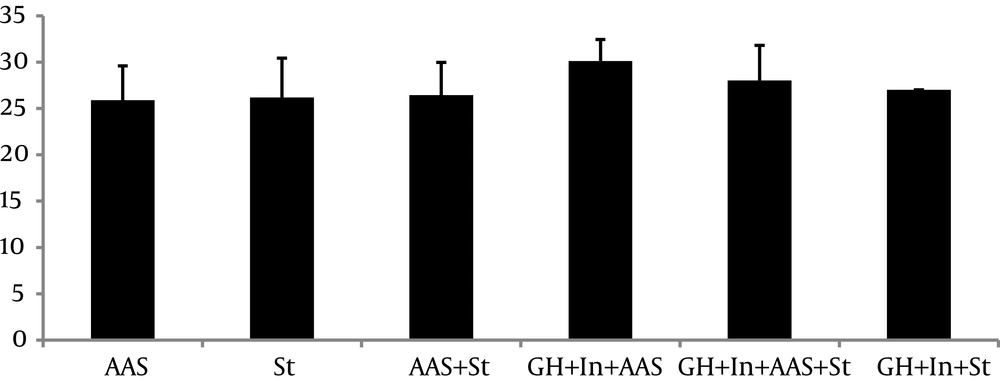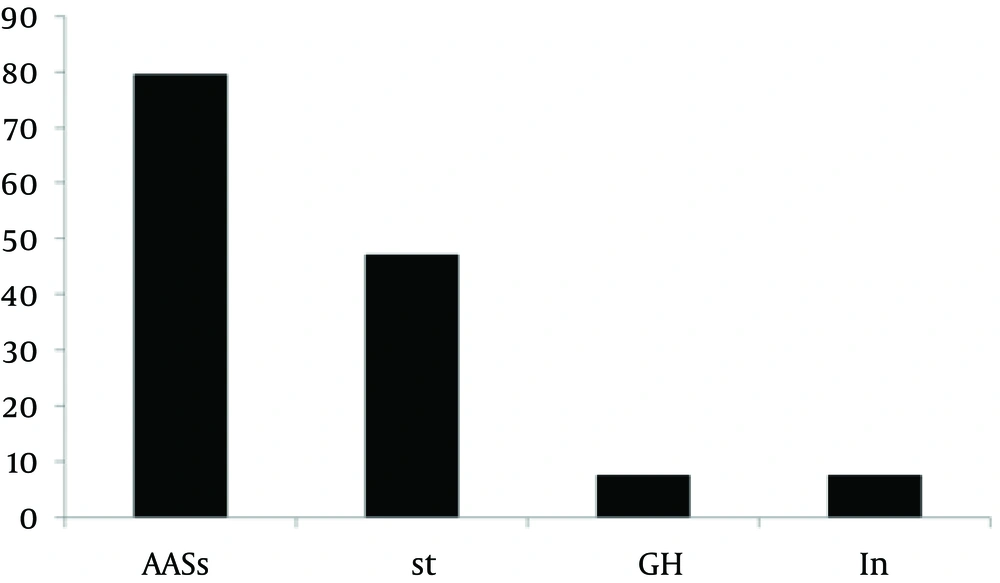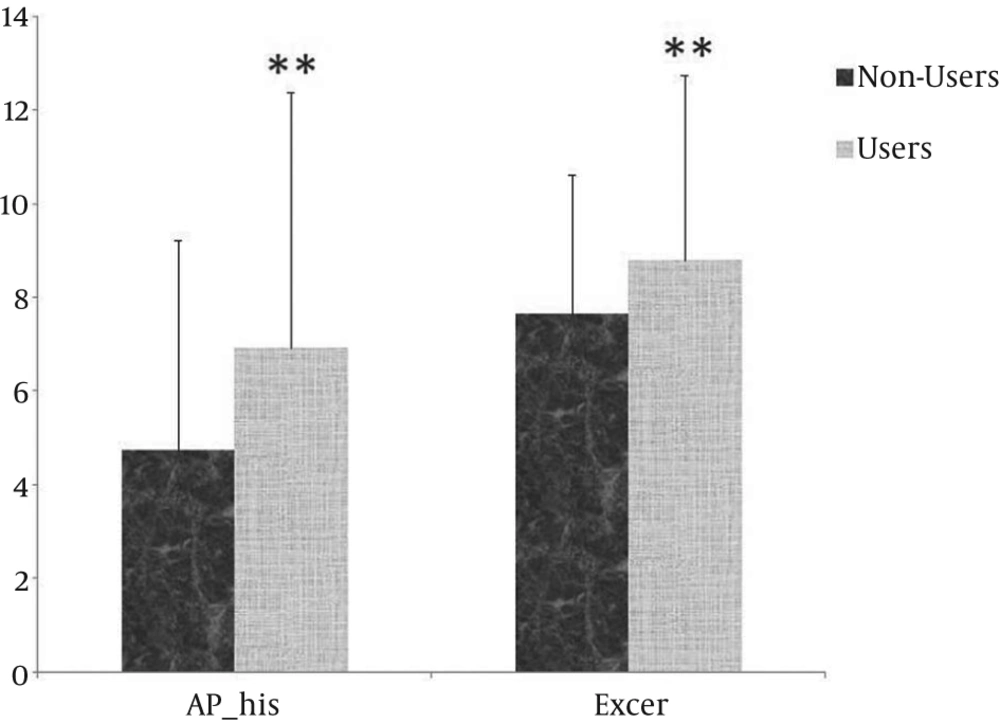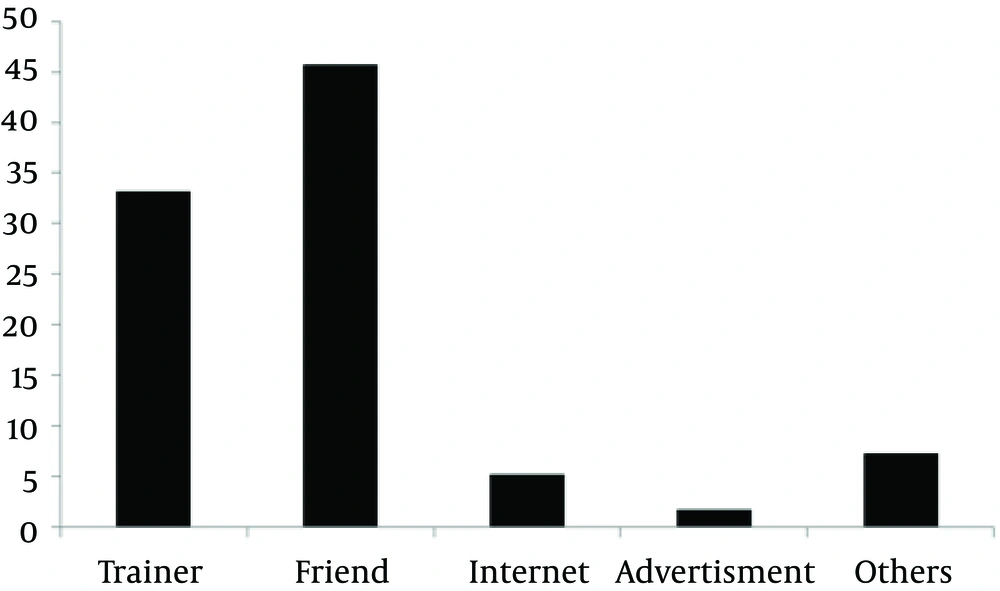1. Background
Performance-enhancing drugs (PEDs) are pharmacologic agents that athletes and non-athletes use to enhance performance or to become leaner or more muscular (1). In sport, doping conventionally refers to the use of PEDs, particularly those that are forbidden by the international world anti-doping agency (WADA) (2). At present, several categories of PEDs are popular among non-competitive (recreational) and professional athletes. The most prevalent agents abused by the athletes are anabolic androgenic steroids (AASs) (1). In addition to AASs, other hormones with potential anabolic activity like human growth hormone (hGH), insulin and insulin-like growth factor-1 (IGF-1) may be abused by the athletes. Recently, the widespread abuse of stimulant agents such as Clenbuterol (an α-adrenergic agonist), amphetamine derivatives, ephedrine, pseudoephedrine and caffeine has been documented among athletes (1, 3-5).
The use of PEDs in sports is not a new phenomenon and dates back centuries; but it became much more popular by the introduction of AASs (1, 6). Numerous investigations have indicated high rate of PED use alongside lack of scientific knowledge about these drugs all over the world (7). In this regard, it was estimated that about 1% of the population misuse AASs, while there are very limited data about use of other types of PED in the different parts of the world (6). Unfortunately, in recent years, widespread use of PEDs among recreational rather than professional athletes has led to the rapid rise of PED use in the different populations around the world (8, 9).
Official and unofficial reports have indicated an increasing rate of PED use among Iranian athletes (10, 11). In this regard, it was demonstrated that 63.3% of Iranian athletes had a history of PED abuse (12). By considering serious adverse effects of PEDs, this high rate of PED abuse can lead to dangerous consequences (10, 13). Therefore, there is pressing need to investigate the prevalence and characteristics of PED use in the different parts of Iran.
2. Objectives
Several reports demonstrated progressive rise of PED use among the Iranian population. More importantly, most of the previous research on the Iranians has mainly focused on AAS abuse, and ignored other agents such as stimulants, growth hormone (GH) and insulin. Moreover, there are very limited reports about the age of the onset of PED use, motivations for use, knowledge about side effects in the Iranian professional and recreational athletes. For these reasons, it is important to investigate the prevalence of all types of PEDs in the Iranian population. Therefore, the aim of this study was to investigate the prevalence and characteristics of PED use among bodybuilding athletes in Bushehr, south of Iran.
3. Methods
3.1. Participants and Study Design
The Research Ethics Committee of Bushehr University of Medical Sciences approved the study and all parts of the investigation were performed in accordance with the declaration of Helsinki. Before introducing the survey, it was emphasized that the collected information would be kept confidential, and the results would be used collectively only for research purposes. We presented detailed information regarding the study objectives and methods to the athletes. After knowing the survey details, the athletes who agreed to participate in the study signed a written consent form.
We randomly selected 11 gyms from Bushehr and consulted with the gym managers for participation in the survey. From these clubs, we invited all bodybuilders who were present at the club at the time of sampling. From all who were invited, athletes who were eligible and agreed to participate were included in the study. Men were eligible to participate in the survey if they regularly participated in strength-training exercise (minimum of 1 year and 4 hour/week). Accordingly, 453 male bodybuilding athletes were recruited from Bushehr gyms between February and May of 2015.
3.2. Data Collection
Data were collected via a face-to-face interview using a survey that took about 30 minutes for each participant. A 44-item survey mostly adopted from Ip and colleagues (14) was used to assess several characteristics of men who participated in the strength training. The survey consisted of three separate sections. In the first section, we asked about the demographic variables such as age, height, weight, marital status, and educational level. In the second section, we asked about exercise patterns (recreational or professional athletes) and history, periodic check of health condition, history of alcohol use, the history of violence, PED use, familiarity with PED side effects, and the use of dietary supplements other than PEDs. If the participants had a history of PED use, we asked the 3rd part of survey. The last part consisted of motivations for PED use, PED acquisition method, age of first PED use, the method of acquisition of PEDs for the first time, the level of awareness about PED effects and side effects before using. Other than above-mentioned items, in the third section, we asked about the type of drugs used, period of PED use, consultation with pharmacist or general practitioner (GP), and the subjective side effects. In this survey, a professional athlete was defined as an individual participating in official sport teams or championship tournaments. Moreover, non-competitive athletes were considered as recreational athletes.
3.3. Data Analysis
We reported continuous data as mean ± SD, and categorical data as numbers and percentages of respondents, mainly because of the descriptive nature of data. Independent group t-test and one way analysis of variance (ANOVA) test (for continuous data) and Chi square test (for categorical data) were used to compare independent variables. For continuous variables that deviated greatly from normality (checked using Kolmogorov-Smirnov test) a nonparametric Wilcoxon rank test or Mann-Whitney U test were used. Moreover, we used the Spearman correlation test to check for relationship between variables. A p value of less than 0.05 was considered to indicate a statistically significant difference. All statistical analyses were conducted using SPSS software for Windows, version 23.
4. Results
4.1. Demographic
The mean age of the participants was 27.02 ± 6.00, with an age range of 16 to 59 years. The participants were mostly in the 20-29-year age group (251 of athletes (55.4%)). It was shown that PED users were significantly older than non-user athletes were (t (451) = - 3.36, P = 0.001). Regarding education, the majority of the athletes had an educational level of high school or higher (322 (93.2%)). Analysis showed that the educational level of PED users was not different from non-user athletes (X2 (2, N = 453) = 2.20, P = 0.33). Details of demographic characteristics are shown in the Table 1.
| Characteristics | User Athletes (%) | Non-User Athletes (%) | P Value |
|---|---|---|---|
| Mean ± SD | |||
| Age | 28.03 ± 6.13 | 25.95 ± 7.07 | 0.001 |
| BMI (kg/m2) | 26.36 ± 3.81 | 24.84 ± 3.37 | 0.000 |
| Number (%) of Participants | |||
| Education | > 0.05 | ||
| Elementary + pre-high school | 20 (8.5) | 11 (5) | |
| High school | 109 (46.6) | 106 (48.4) | |
| University | 105 (44.9) | 102 (46.6) | |
| Obesity | 0.000 | ||
| Normal | 77 (32.9) | 126 (57.5) | |
| Overweight | 119 (50.9) | 81 (37) | |
| Obese | 38 (16.2) | 12 (5.5) | |
| Marriage status | |||
| Single | 159 (67.9) | 161 (73.5) | > 0.05 |
| Married | 75 (32.1) | 58 (5.5) | |
The Demographic Information of Male Bodybuilding (Performance Enhancing Drug Users and Non-Users) Athletes
The PED users weighed significantly more (83.07 ± 12.86 vs. 77.68 ± 11.47 kg, t (451) = - 4.70, P = 0.000) with a corresponding greater body mass index than the non-users ([BMI] 26.36 ± 3.81 vs. 24.84 ± 3.37 kg/m2, respectively, t (451) = - 4.48, P = 0.000). In addition, the prevalence of overweightness and obesity were higher among PED users in comparison to the non-users (X2 (2, N = 453) = 32.11, P = 0.000) (Table 1). Moreover, regarding BMI, there were significant differences between different groups of PEDs users (X2 (10, N = 234) = 21.13, P = 0.000) (Figure 1).
4.2. Alcohol Use And History of Aggressiveness
In general, 163 (36%) of participants stated that they had used alcohol. Again, PED users were more likely to drink alcoholic beverages (X2 (1, N = 453) = 16.60, P = 0.001) (Table 2). However, there were no differences regarding alcohol use among different class of PED users (X2 (5, 234) = 4.66, P = 0.46). Moreover, 53 (11.7%) of all participants had a history of violence. Similarly, the PEDs users tended to be more involved in the aggressive behavior than non-users (X2(1, N = 453) = 15.88, P = 0.001) (Table 2).
| Characteristics | No. of User Athletes (%) | No. of Non-User Athletes (%) | P Value |
|---|---|---|---|
| Exercise condition | 0.000 | ||
| Recreational | 184 (78.6) | 207 (94.5) | |
| Professional | 50 (21.4) | 12 (5.5) | |
| Violence | 0.000 | ||
| Yes | 41 (17.5) | 12 (5.5) | |
| No | 193 (82.5) | 207 (94.5) | |
| Alcohol use | 0.000 | ||
| Yes | 105 (44.9) | 58 (26.5) | |
| No | 129 (55.1) | 105 (73.5) | |
| Knowledge about side effects | 0.000 | ||
| Yes | 196 (83.8) | 153 (63.9) | |
| No | 38 (16.2) | 66 (30.1) |
The characteristics of male bodybuilding athletesa
4.3. Characteristics of PEDs Use
According to this study, 234 of bodybuilding athletes (51.7%) were using or had a history of PED use. The PED abusers administered an average of 3.80 ± 4.52 PEDs during their routines. Moreover, most of the participants (70.6%) were single and only 29.4% were married. In this study, 86.3% of participants were recreational athletes, while only 13.7% of participants were professional athletes (Table 2). They used drugs from different classes such as AASs, stimulants, growth hormone, and insulin. In this line, the most prevalent agents used by the participants were AASs (185 athletes (79.40%)) (Figure 2). Moreover, 110 of the participants (47.00%) reported stimulant agent administration during their routines (Figure 2). Furthermore, professional athletes were more likely to use PEDs in comparison with recreational athletes (50 athletes (80.60%) vs. 12 athletes (47.10%), respectively, X2 (1, N = 453) = 24.17, P = 0.000). Moreover, the PED users tended to have more years of strength training experience than non-users did (6.90 ± 5.46 vs. 4.74 ± 4.45 years, respectively, P = 0.000) (Figure 3). Additionally, the PED users underwent strength training for significantly more hours/week compared to the non-users (8.79 ± 3.9 vs. 7.64 ± 2.96 hours, respectively, P = 0.001) (Figure 3).
The average age of first PEDs use was 23.46 ± 5.57 years. The results of this study showed that 165 of the athletes (71.40%) had used PEDs for the first time before the age of 25. In addition, 66 of bodybuilding athletes (28.60%) initiated PEDs use after they were 26 years old, while only five athletes (2.20%) reported onset age of before 15 years. Moreover, the age of first PEDs use was significantly different between different classes of PED users (P = 0.016). The PED users had used PEDs for the average of 3.24 ± 4.52 years and the average PEDs cycle length was 60.67 ± 38.00 days/year. Furthermore, the average years of training exercise had direct relation with the length of PEDs use cycle (r (453) = 0.37, P = 0.000).
Only 92 of PED users (39.50%) had complete knowledge about the effects of PED use before initiation of use. On the other hand, 77 of PEDs users (33%) had no information about PEDs side effects before initiation of PED use (Table 2). Among PED users, only 49 participants (21%) had consulted about the PEDs use, side effects, route and dose of PED administration with a specialist (GP or pharmacist). In general, only 160 athletes (39.30%) assessed their health status by regular laboratory testing. Although, PED users are more likely to use laboratory tests to check for health than non-users, the difference was not statistically significant (X2(1, N = 453) = 3.38, P = 0.077).
The PEDs user participants were asked to disclose the way of acquaintance with PEDs at the initiation of use. According to them, 116 of PED users (50.00%) had become familiar with PEDs via their friends before beginning of PED use. Other than friends, athlete trainers, internet and TV advertisement had contributed to the acquaintance of athletes with the PEDs (Figure 4).
4.4. Motivation for Use
Our study showed that the primary motivations for starting PED use by bodybuilding athletes was as followa: increasing muscle mass (164 PED user athletes (70.10%)), increasing strength (131 PED user athletes (56%)), weight gain or loss (95 PEDs user athletes (40.60%)), improving sport performance (68 PEDs user athletes (29.10%)), increasing endurance (60 PEDs user athletes (25.60%)), improving physical appearance (43 PEDs user athletes (18.40%)) and preventing injury (31 PEDs user athletes (13.20%)). Moreover, AAS were the most important factors for increasing muscle mass, weight gain. On the other hand, stimulants were mainly used to increase strength, endurance and performance. In addition, the most important motivation for athletes who used stimulants, GH and insulin together was losing weight.
4.5. Acquisition
Most of the users (159 athletes (69.40%)) obtained their AAS supply from local and illicit sources (friends, training partners, gym members, or dealers); 25 PED user athletes (10.9%) acquired the drugs from drugstores and 45 users (19.7%) obtained drugs from both drug stores and illicit sources.
4.6. Adverse Effects
We asked PED users to report adverse drug effects after using PEDs. The most prevalent adverse effects reported by the PED users were sexual effects (increased or decreased libido, gynecomastia) (49.4%), dermatologic effects (acne, hair loss, hirsutism) (44.2%), weight gain or loss (37.3%), psychological effects (aggressiveness, anxiety, depression, nervousness, restlessness) (33.0%) and increased or decreased urination (20.2%). Other side effects such as cardiovascular effects, damage to the muscles and tendons, delayed wound healing, infection, jaundice and unknown mass in the body were reported by the less than 10% of PED users. Only 23.5% of PED users reported no adverse effects from PED use.
The prevalence of reported side effects was different among different groups of PED users. In this regard, the prevalence of sexual effects (X2 (5, N = 234) = 38.35, P = 0.000), risk of infection (X2 (5, N = 234) = 28.59, P = 0.000), dermatologic effects (X2 (5, N = 234) = 30.44, P = 0.000), psychiatric effects (X2 (5, N = 234) = 13.24, P = 0.021), weight gain or loss (X2 (5, N = 234) = 26.95, P = 0.000) and urinary effects (X2 (5, N = 234) = 11.5, P = 0.042) were significantly different in the different groups of PEDs users.
4.7. Use of Non-PEDs Dietary Supplements
Participants had used wide range of dietary supplements. The most important dietary supplements that had been used by the athletes were as follow: protein, amino acids, glutamine, carbohydrates, and creatine. In general, 71.3% of all participants had used legal dietary supplements. It was shown that PED users are much more likely to consume dietary supplements (X2 (1, N = 453) = 84.22, P = 0.000).
5. Discussion
5.1. Demographic
This study confirmed the high prevalence of PED abuse among bodybuilding athletes in the south of Iran. Our study showed that more than half of the bodybuilding athletes had a history of PED use. This rate of PED use is higher than other studies that investigated PED use among Iranian athletes. In this regard, self-report study had shown that the probability of lifetime use of AASs in bodybuilding athletes was 24.5% in Kerman (a city of Iran) (15). Another study showed that 32.1% of bodybuilders had used doping agents in Kermanshah (another city of Iran) (16). This higher prevalence might be related to easier access of Bushehr athletes to the PEDs that were imported from foreign countries. In this regard, high rate of PED acquisition by the illicit sources in this study may be a proof of this idea. Moreover, almost all of other studies have focused on AAS as the most prevalent PEDs of abuse. In contrast, we reported the prevalence of all types of PEDs in the bodybuilding athletes.
According to our study, PED users had significantly higher BMI in comparison to non-user athletes. Moreover, only PED users had an average BMI greater than normal (18.5 - 24.9). In agreement with our study, it was shown that the AAS users had higher BMIs and body weights than their non-AAS counterparts, as might be expected due to the increased lean body mass with AAS administration (14, 17). However, it is possible that overweight or obese athletes have used some PEDs to reduce weight. In line with this idea, our study showed that the average BMI of athletes who were using GH was higher than only AAS or stimulant users. Moreover, the BMI of non-users was not significantly different from only AAS or stimulant users. Therefore, it is possible to assume that losing weight is an important motivation for athletes to use some PEDs like GH. In accordance, it was shown that GH administration has reduced abdominal fat in the abdominally obese men (18) and might improve social presentation of appearance (14). In line with this idea, our study showed that the most important motivation for using GH by the athletes was losing weight.
In agreement with other studies (14), the majority of PED users who participated in our study were recreational rather than professional athletes. This may imply the importance of other motivations rather than the performance enhancement for using PEDs among bodybuilding athletes. Likewise, our study showed that increasing muscle mass and strength were more important than improving performance for especially recreational athletes who used PEDs. Although, the majority of PEDs users in our study were recreational athletes, it is noteworthy that professional athletes were more likely to be involved in the PEDs abuse.
5.2. Alcohol Use and History of Aggressiveness
Our study demonstrated high prevalence of alcohol use among bodybuilding athletes. Moreover, PEDs abusers were more likely to use alcohol when compared with non-users. In accordance with our study, it was shown that AASs use have been involved with the abuse of other illicit drugs such as alcohol and morphine (19). However, some investigations have reported no differences in alcohol or other illicit drug use between PEDs user and non-user athletes (14). Moreover, it is not completely clear that AASs use increases the risk of alcohol use or alcohol use raises the likelihood of AASs abuse (20).
Our study showed that PEDs users in comparison with non-users were more involved in the violence and aggressive behavior. In line with the present study, it was shown that the prevalence of aggressive behavior was higher in AASs user in comparison with non-users (21). Moreover, this higher representation of aggressive behavior, at least partly, may be related to the stimulant agent’s abuse or interaction of AASs with stimulants. In this regard, we found that athletes who used AASs and stimulants together were more likely to be involved in the aggressive behavior in comparison to the only AAS or stimulant users.
5.3. Characteristics of PEDs Use
In line with other studies (22), ours showed that mid 20s is the median age of initiation of PED use. It is important to notice that the majority of athletes initiated PED use before the age of 25 while very small numbers of bodybuilders reported onset age of PED use before 15. Moreover, a considerable number of athletes initiated PED use before the age of 20 (37.7%). In contrast, other studies reported that 24.8% of western athletes had reported PED use before the age of 20 (1). This may imply the easier access of Iranian athletes especially adolescents to the PEDs. Moreover, in the present study the age of first use of AASs was lower than stimulant agent’s use. This may be mainly because of the popularity of AASs among bodybuilding athletes. Furthermore, AASs may be the most available agents in the gyms.
It is important to notice that the majority of athletes had not had complete knowledge about the effects and adverse effects of PEDs before the initiation of PEDs administration. Moreover, they did not consult with a pharmacist or GP about the administration and effects of these drugs. In this regard, it was shown that most PED users did not reveal PED use to any physician (23) mostly because they did not trust physicians (1). In accordance, they acquired information about PEDs from unsuitable sources. Another study, in accords with ours, showed that friends and coaches rather than physicians were the most important sources of information about PED administration (10). Accordingly, it is unfortunate to state that starting PED use in adolescence without consultation with a physician or pharmacist and lack of complete knowledge about these agents may predispose athletes to the risk of serious adverse effects.
Our study indicated that increasing muscle mass, increasing strength and weight gain or loss were the most important motivations for using PEDs. In accordance with our study, it was demonstrated that increasing muscle mass and improving strength were among the most important motivations for using PEDs specially AASs (14, 22). Consequently, some of these motivations may reflect the high rate of AAS use among bodybuilding athletes. In this regard, Wright and colleagues (2001) (24) have found that increased muscle mass was the primary motive to use AASs. In recent decades, social media and cultural expectation in different parts of the world try to represent men with a more muscular body (25, 26). Therefore, at the present time men prefer to look more muscular than their actual state (27) and according to athletes using PEDs especially AASs might be the simplest way to achieve this goal.
The participants of our study reported use of about four agents during their schedules. It was revealed that polypharmacy was a common practice among bodybuilding athletes who use PEDs (14, 28) that can increase the risk of adverse effects among PED users (29). In this regard, 76.5% of PED users reported various side effects after administration of these agents. Our participants reported that increasing or decreasing libido, gynecomastia, acne, hirsutism, hair loss, weight gain or loss and psychological effects as the primary adverse effects after administration of PEDs. In this line, previous studies emphasized on the role of AAS in producing many of these side effects (1). Our study confirmed that AAS use increases the likelihood of sexual and dermatologic side effects. In addition, bodybuilding athletes who use AAS were more prone to gain weight. Moreover, athletes who co-administered both AASs and stimulants reported higher rate of jaundice and psychoactive effects in comparison to the only AASs or stimulant users.
The limitation of these types of retrograde studies is that information-gathering is based on the participant. In order to overcome this limitation, we referred athletes to the lab for measuring follicle-stimulating hormone (FSH) and luteinizing hormone (LH). However, only about one third of athletes went to the lab. Therefore, we could not able to include the confirmed lab results into the study.
In conclusion, this study showed a high rate of PED use among Iranian bodybuilding athletes, which can expose them to the various side effects. Moreover, we recommend evaluating the prevalence of PED use in other sports such as cycling and wrestling.



